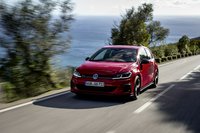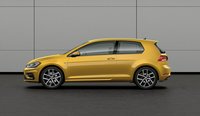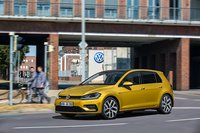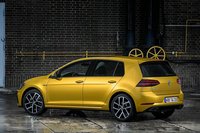Volkswagen Golf 7 facelift
Compact HatchbackProduct Gallery








Product Overview
Volkswagen Golf 7 facelift is a compact hatchback in production from 2017 to 2020. It was powered by a range of inline-3 and inline-4 engines that displaced 1.0 to 2.0 liters.
Compared to the pre-facelift model, the facelifted Mk7 Golf comes with further-downsized yet more heavily-boosted engines.
Volkswagen has made a good effort in aerodynamics, with a decent 0.28 coefficient of drag to show for it. The official fuel economy rating is exceptionally rosy, though it may cast more doubts on the trustworthiness of the regulators and perhaps the owner's own sanity than it relates to reality.
Drivers who appreciate handling should keep in mind that the Volkswagen Golf VII (facelift 2017) uses MacPherson front suspension, which doesn't provide the best cornering performance.
Ratings
What we found
Neofiliac score 65%
Pros
- Good 0.28 drag coefficient
- Low fuel consumption
- Good 7-speed DSG
- Fully independent suspension setup
Cons
- Only available with small engines
- Stuck with MacPherson struts in the front
What external reviewers found
External score 75%
Pros
- Excellent infotainment system
- Excellent handling
- Excellent infotainment
- Impressive handling
Cons
- Lacklustre ride quality
- Not as agile as its predecessor
- Dull interior
- Not as fun as a 205 GTI
- Not as sporty as rivals
- Not the most fun to drive
Your rating:
12345678910
?/10
Price Comparison
As associates of the merchants above, we earn a commission when you make a purchase using the supplied links.
Specifications
Variants shown:
1.0 TSI 110
1.0 TSI 110 DCT
1.0 TSI 116
1.0 TSI 116 DCT
1.0 TSI 85
1.4 TGI 110
1.4 TGI 110 DCT
1.4 TSI 125
1.4 TSI 125 DCT
1.4 TSI 147
1.4 TSI 147 AT
1.4 TSI 150
1.4 TSI 150 DCT
1.5 TGI 130
1.5 TGI 130 DCT
1.5 TSI 131
1.5 TSI 131 DCT
1.5 TSI 150
1.5 TSI 150 DCT
1.6 TDI 115
1.6 TDI 115 DCT
2.0 TDI 150
2.0 TDI 150 4MOTION
2.0 TDI 150 DCT
2.0 TDI 150 4MOTION DCT
GTD
GTD DCT
GTI 228
GTI 228 DCT
GTI 230
GTI 230 DCT
GTI Performance 245
GTI Performance DCT
GTI Performance Euro6d DCT
GTI 290 DCT
R 310 4MOTION
R 310 4MOTION DCT
[[{"Ft":"Capacity","Fn":"Cargo Capacity","Fv":"380 L / 13.4 cu-ft ~ 1270 L / 44.8 cu-ft"},{"Ft":"Capacity","Fn":"Coolant Capacity","Fv":"10.0 L / 10.6 qt"},{"Ft":"Capacity","Fn":"Engine Oil Capacity","Fv":"4.0 L / 4.2 qt"},{"Ft":"Capacity","Fn":"Fuel Capacity","Fv":"50.0 L / 13.2 gal"},{"Ft":"Capacity","Fn":"Passengers","Fv":"5"},{"Ft":"Capacity","Fn":"Payload","Fv":"579 kg / 1276 lbs"},{"Ft":"Chassis","Fn":"Brakes | Front","Fv":"Ventilated discs"},{"Ft":"Chassis","Fn":"Brakes | Rear","Fv":"Disc"},{"Ft":"Chassis","Fn":"Power Steering","Fv":"Electric Steering"},{"Ft":"Chassis","Fn":"Suspension | Front","Fv":"MacPherson strut"},{"Ft":"Chassis","Fn":"Suspension | Rear","Fv":"Multi-link"},{"Ft":"Chassis","Fn":"Tire Size","Fv":"205/55 R16"},{"Ft":"Chassis","Fn":"Turning Circle","Fv":"10.9 m / 35.8 ft"},{"Ft":"Construction","Fn":"Battery | Capacity","Fv":"35.8 kWh (gross) | 32.0 kWh (net)"},{"Ft":"Construction","Fn":"Battery | Type","Fv":"Lithium-ion"},{"Ft":"Construction","Fn":"Battery | Voltage","Fv":"323.0 V"},{"Ft":"Construction","Fn":"Body Style","Fv":"3- / 5-door Hatchback"},{"Ft":"Dimensions","Fn":"Ground Clearance","Fv":"133 mm / 5.2 in"},{"Ft":"Dimensions","Fn":"Size | Height","Fv":"1492 mm / 58.7 in"},{"Ft":"Dimensions","Fn":"Size | Length","Fv":"4258 mm / 167.6 in"},{"Ft":"Dimensions","Fn":"Size | Width","Fv":"1799 mm / 70.8 in"},{"Ft":"Dimensions","Fn":"Track Width | Front","Fv":"1549.0 mm / 61.0 in"},{"Ft":"Dimensions","Fn":"Track Width | Rear","Fv":"1521.0 mm / 59.9 in"},{"Ft":"Dimensions","Fn":"Weight","Fv":"1141.0 kg / 2515.5 lbs"},{"Ft":"Dimensions","Fn":"Wheel Size","Fv":"6.5 J x 16"},{"Ft":"Dimensions","Fn":"Wheelbase","Fv":"2620 mm / 103.1 in"},{"Ft":"Performance","Fn":"Acceleration | 0 - 100 km/h","Fv":"9.9 sec"},{"Ft":"Performance","Fn":"Acceleration | 0 - 60 mph","Fv":"9.4 sec"},{"Ft":"Performance","Fn":"CO2 Emission","Fv":"109 ~ 112 g/km"},{"Ft":"Performance","Fn":"Coefficient Of Drag","Fv":"0.29"},{"Ft":"Performance","Fn":"Fuel Economy","Fv":"4.8 L/100km / 49.0 MPG (combined) | 5.9 L/100km / 39.9 MPG (urban) | 4.1 L/100km / 57.4 MPG (highway)"},{"Ft":"Performance","Fn":"Top Speed","Fv":"196.0 km/h / 121.8 mph"},{"Ft":"Performance","Fn":"Towing Capacity","Fv":"600 kg / 1323 lbs (w/o brakes) | 1500 kg / 3307 lbs (w/ brakes @ 8% gradient) | 1300 kg / 2866 lbs (w/ brakes @ 12% gradient)"},{"Ft":"Powertrain","Fn":"Drivetrain Layout","Fv":"Front-engine (transverse), Front-wheel drive"},{"Ft":"Powertrain","Fn":"Emission Standard","Fv":"Euro 6"},{"Ft":"Powertrain","Fn":"Engine","Fv":"CHZC"},{"Ft":"Powertrain","Fn":"Engine | Bore","Fv":"74.5 mm / 2.9 in"},{"Ft":"Powertrain","Fn":"Engine | Compression Ratio","Fv":"10.0:1"},{"Ft":"Powertrain","Fn":"Engine | Displacement","Fv":"1.0 L / 61.0 cu-in / 999.0 cc"},{"Ft":"Powertrain","Fn":"Engine | Power","Fv":"110.0 hp / 82.0 kW @ 5000-5500 rpm"},{"Ft":"Powertrain","Fn":"Engine | Specific Output","Fv":"110.1 hp/L / 1.8 hp/cu-in"},{"Ft":"Powertrain","Fn":"Engine | Stroke","Fv":"80.0 mm / 3.1 in"},{"Ft":"Powertrain","Fn":"Engine | Torque","Fv":"200 Nm / 147.5 lb-ft @ 2000-3500 rpm"},{"Ft":"Powertrain","Fn":"Engine | Type","Fv":"Turbocharged direct-injected petrol inline-3 engine with 4 values per cylinder"},{"Ft":"Powertrain","Fn":"Transmission | Gears","Fv":"6-speed"},{"Ft":"Powertrain","Fn":"Transmission | Type","Fv":"Manual"},{"Ft":"Production","Fn":"Availability","Fv":"2017 ~ 2019"}],[{"Ft":"Capacity","Fn":"Cargo Capacity","Fv":"380 L / 13.4 cu-ft ~ 1270 L / 44.8 cu-ft"},{"Ft":"Capacity","Fn":"Coolant Capacity","Fv":"10.0 L / 10.6 qt"},{"Ft":"Capacity","Fn":"Engine Oil Capacity","Fv":"4.0 L / 4.2 qt"},{"Ft":"Capacity","Fn":"Fuel Capacity","Fv":"50.0 L / 13.2 gal"},{"Ft":"Capacity","Fn":"Passengers","Fv":"5"},{"Ft":"Capacity","Fn":"Payload","Fv":"579 kg / 1276 lbs"},{"Ft":"Chassis","Fn":"Brakes | Front","Fv":"Ventilated discs"},{"Ft":"Chassis","Fn":"Brakes | Rear","Fv":"Disc"},{"Ft":"Chassis","Fn":"Power Steering","Fv":"Electric Steering"},{"Ft":"Chassis","Fn":"Suspension | Front","Fv":"MacPherson strut"},{"Ft":"Chassis","Fn":"Suspension | Rear","Fv":"Multi-link"},{"Ft":"Chassis","Fn":"Tire Size","Fv":"205/55 R16"},{"Ft":"Chassis","Fn":"Turning Circle","Fv":"10.9 m / 35.8 ft"},{"Ft":"Construction","Fn":"Battery | Capacity","Fv":"35.8 kWh (gross) | 32.0 kWh (net)"},{"Ft":"Construction","Fn":"Battery | Type","Fv":"Lithium-ion"},{"Ft":"Construction","Fn":"Battery | Voltage","Fv":"323.0 V"},{"Ft":"Construction","Fn":"Body Style","Fv":"3- / 5-door Hatchback"},{"Ft":"Dimensions","Fn":"Ground Clearance","Fv":"133 mm / 5.2 in"},{"Ft":"Dimensions","Fn":"Size | Height","Fv":"1492 mm / 58.7 in"},{"Ft":"Dimensions","Fn":"Size | Length","Fv":"4258 mm / 167.6 in"},{"Ft":"Dimensions","Fn":"Size | Width","Fv":"1799 mm / 70.8 in"},{"Ft":"Dimensions","Fn":"Track Width | Front","Fv":"1549.0 mm / 61.0 in"},{"Ft":"Dimensions","Fn":"Track Width | Rear","Fv":"1521.0 mm / 59.9 in"},{"Ft":"Dimensions","Fn":"Weight","Fv":"1161.0 kg / 2559.6 lbs"},{"Ft":"Dimensions","Fn":"Wheel Size","Fv":"6.5 J x 16"},{"Ft":"Dimensions","Fn":"Wheelbase","Fv":"2620 mm / 103.1 in"},{"Ft":"Performance","Fn":"Acceleration | 0 - 100 km/h","Fv":"9.9 sec"},{"Ft":"Performance","Fn":"Acceleration | 0 - 60 mph","Fv":"9.4 sec"},{"Ft":"Performance","Fn":"CO2 Emission","Fv":"107 ~ 109 g/km"},{"Ft":"Performance","Fn":"Coefficient Of Drag","Fv":"0.29"},{"Ft":"Performance","Fn":"Fuel Economy","Fv":"4.7 L/100km / 50.0 MPG (combined) | 5.6 L/100km / 42.0 MPG (urban) | 4.2 L/100km / 56.0 MPG (highway)"},{"Ft":"Performance","Fn":"Top Speed","Fv":"196.0 km/h / 121.8 mph"},{"Ft":"Performance","Fn":"Towing Capacity","Fv":"610 kg / 1345 lbs (w/o brakes) | 1500 kg / 3307 lbs (w/ brakes @ 8% gradient) | 1300 kg / 2866 lbs (w/ brakes @ 12% gradient)"},{"Ft":"Powertrain","Fn":"Drivetrain Layout","Fv":"Front-engine (transverse), Front-wheel drive"},{"Ft":"Powertrain","Fn":"Emission Standard","Fv":"Euro 6"},{"Ft":"Powertrain","Fn":"Engine","Fv":"CHZC"},{"Ft":"Powertrain","Fn":"Engine | Bore","Fv":"74.5 mm / 2.9 in"},{"Ft":"Powertrain","Fn":"Engine | Compression Ratio","Fv":"10.0:1"},{"Ft":"Powertrain","Fn":"Engine | Displacement","Fv":"1.0 L / 61.0 cu-in / 999.0 cc"},{"Ft":"Powertrain","Fn":"Engine | Power","Fv":"110.0 hp / 82.0 kW @ 5000-5500 rpm"},{"Ft":"Powertrain","Fn":"Engine | Specific Output","Fv":"110.1 hp/L / 1.8 hp/cu-in"},{"Ft":"Powertrain","Fn":"Engine | Stroke","Fv":"80.0 mm / 3.1 in"},{"Ft":"Powertrain","Fn":"Engine | Torque","Fv":"200 Nm / 147.5 lb-ft @ 2000-3500 rpm"},{"Ft":"Powertrain","Fn":"Engine | Type","Fv":"Turbocharged direct-injected petrol inline-3 engine with 4 values per cylinder"},{"Ft":"Powertrain","Fn":"Transmission | Gears","Fv":"7-speed"},{"Ft":"Powertrain","Fn":"Transmission | Type","Fv":"DCT DSG"},{"Ft":"Production","Fn":"Availability","Fv":"2017 ~ 2019"}],[{"Ft":"Capacity","Fn":"Cargo Capacity","Fv":"380 L / 13.4 cu-ft ~ 1270 L / 44.8 cu-ft"},{"Ft":"Capacity","Fn":"Coolant Capacity","Fv":"10.0 L / 10.6 qt"},{"Ft":"Capacity","Fn":"Engine Oil Capacity","Fv":"4.0 L / 4.2 qt"},{"Ft":"Capacity","Fn":"Fuel Capacity","Fv":"50.0 L / 13.2 gal"},{"Ft":"Capacity","Fn":"Passengers","Fv":"5"},{"Ft":"Capacity","Fn":"Payload","Fv":"515 kg / 1135 lbs"},{"Ft":"Chassis","Fn":"Brakes | Rear","Fv":"Disc"},{"Ft":"Chassis","Fn":"Power Steering","Fv":"Electric Steering"},{"Ft":"Chassis","Fn":"Suspension | Front","Fv":"MacPherson strut"},{"Ft":"Chassis","Fn":"Suspension | Rear","Fv":"Multi-link"},{"Ft":"Chassis","Fn":"Tire Size","Fv":"205/55 R16"},{"Ft":"Chassis","Fn":"Turning Circle","Fv":"10.9 m / 35.8 ft"},{"Ft":"Construction","Fn":"Battery | Capacity","Fv":"35.8 kWh (gross) | 32.0 kWh (net)"},{"Ft":"Construction","Fn":"Battery | Type","Fv":"Lithium-ion"},{"Ft":"Construction","Fn":"Battery | Voltage","Fv":"323.0 V"},{"Ft":"Construction","Fn":"Body Style","Fv":"3- / 5-door Hatchback"},{"Ft":"Dimensions","Fn":"Ground Clearance","Fv":"142 mm / 5.6 in"},{"Ft":"Dimensions","Fn":"Size | Height","Fv":"1492 mm / 58.7 in"},{"Ft":"Dimensions","Fn":"Size | Length","Fv":"4258 mm / 167.6 in"},{"Ft":"Dimensions","Fn":"Size | Width","Fv":"1790 mm / 70.5 in | 2027 mm / 79.8 in (mirror unfolded)"},{"Ft":"Dimensions","Fn":"Track Width | Front","Fv":"1533.0 mm / 60.4 in"},{"Ft":"Dimensions","Fn":"Track Width | Rear","Fv":"1504.0 mm / 59.2 in"},{"Ft":"Dimensions","Fn":"Weight","Fv":"1245.0 kg / 2744.8 lbs"},{"Ft":"Dimensions","Fn":"Wheel Size","Fv":"6.5J x 16"},{"Ft":"Dimensions","Fn":"Wheelbase","Fv":"2620 mm / 103.1 in"},{"Ft":"Performance","Fn":"Acceleration | 0 - 100 km/h","Fv":"9.8 sec"},{"Ft":"Performance","Fn":"Acceleration | 0 - 60 mph","Fv":"9.3 sec"},{"Ft":"Performance","Fn":"CO2 Emission","Fv":"109 ~ 113 g/km"},{"Ft":"Performance","Fn":"Coefficient Of Drag","Fv":"0.29"},{"Ft":"Performance","Fn":"Fuel Economy","Fv":"4.8 L/100km / 49.0 MPG (combined) | 5.4 L/100km / 43.6 MPG (urban) | 4.4 L/100km / 53.5 MPG (highway)"},{"Ft":"Performance","Fn":"Top Speed","Fv":"198.0 km/h / 123.0 mph"},{"Ft":"Performance","Fn":"Towing Capacity","Fv":"620 kg / 1367 lbs (w/o brakes) | 1500 kg / 3307 lbs (w/ brakes @ 8% gradient) | 1300 kg / 2866 lbs (w/ brakes @ 12% gradient)"},{"Ft":"Powertrain","Fn":"Drivetrain Layout","Fv":"Front-engine (transverse), Front-wheel drive"},{"Ft":"Powertrain","Fn":"Emission Standard","Fv":"Euro 6d-TEMP"},{"Ft":"Powertrain","Fn":"Engine","Fv":"DKRA, DKRF"},{"Ft":"Powertrain","Fn":"Engine | Bore","Fv":"74.5 mm / 2.9 in"},{"Ft":"Powertrain","Fn":"Engine | Compression Ratio","Fv":"10.0:1"},{"Ft":"Powertrain","Fn":"Engine | Displacement","Fv":"1.0 L / 61.0 cu-in / 999.0 cc"},{"Ft":"Powertrain","Fn":"Engine | Power","Fv":"116.0 hp / 86.5 kW"},{"Ft":"Powertrain","Fn":"Engine | Specific Output","Fv":"116.1 hp/L / 1.9 hp/cu-in"},{"Ft":"Powertrain","Fn":"Engine | Stroke","Fv":"80.0 mm / 3.1 in"},{"Ft":"Powertrain","Fn":"Engine | Torque","Fv":"200 Nm / 147.5 lb-ft @ 2000-3500 rpm"},{"Ft":"Powertrain","Fn":"Engine | Type","Fv":"Turbocharged direct-injected petrol inline-3 engine with 4 values per cylinder"},{"Ft":"Powertrain","Fn":"Transmission | Gears","Fv":"6-speed"},{"Ft":"Powertrain","Fn":"Transmission | Type","Fv":"Manual"},{"Ft":"Production","Fn":"Availability","Fv":"2018 ~ 2019"}]]
External Reviews
autocar[1]
Reviewer score 79% (normalized by Neofiliac)Latest Golf is based around a carry-over platform and chassis. Lower end models continue to receive a MacPherson strut (front) and torsion beam (rear) suspension. Upper-end models, including this 1.5 eTSI, run a more sophisticated combination of Mac pherson struts and multi-links. All models receive passive dampers as standard, though as with its predecessor the new Golf works best with optional continuously variable dampers.
Pros
- Gorgeous design
- Impressive handling
- New age digital and connectivity features
Cons
- Not as agile as its predecessor
autoexpress[2]
Reviewer score 65% (normalized by Neofiliac)The Mk7 Golf R was launched in March 2014 with an even more potent and mouth-watering 296bhp. Power came from a 2.0-litre four-cylinder turbocharged petrol engine. By July 2015 the R was also offered in a more practical Estate body style. An updated Golf R arrived in April 2016 with LED lights all round, digital dials, a new infotainment system and a 10bhp boost.
Pros
- Sleek interior
- Excellent infotainment system
- Good standard equipment
Cons
- Cheap to buy and run
- Skeaky door rubbers
carmagazine[3]
Reviewer score 73% (normalized by Neofiliac)Like any car of its era, the GTI isn't immune to rust. Today's mania for modern classics means you'll struggle to find a solid one for less than five figures. An immaculate Campaign like this is probably nigh-on £30,000: on par with a new GTI Performance.
Pros
- Gorgeous styling
- Punchy engine
- Comfortable to drive
Cons
- Not as fun as a 205 GTI
- Fiddly brakes
Also Check
References
<
>
x